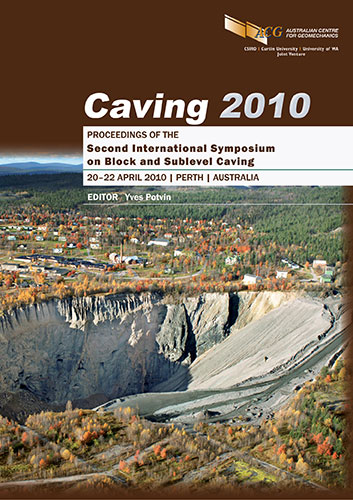The role of geotechnical engineering during the prefeasibility studies and early works of Cadia East panel caving project, New South Wales, Australia

|
Authors: Catalan, A; Sinaga, F; Qudraturrahman, I |
DOI https://doi.org/10.36487/ACG_rep/1002_27_Catalan2
Cite As:
Catalan, A, Sinaga, F & Qudraturrahman, I 2010, 'The role of geotechnical engineering during the prefeasibility studies and early works of Cadia East panel caving project, New South Wales, Australia', in Y Potvin (ed.), Caving 2010: Proceedings of the Second International Symposium on Block and Sublevel Caving, Australian Centre for Geomechanics, Perth, pp. 389-406, https://doi.org/10.36487/ACG_rep/1002_27_Catalan2
Abstract:
Cadia East underground project will be one of the largest and deepest panel caves in Australia. The first extraction level will be situated about 1,200 m below surface and a second lift located about 1,400 m which shall be brought into operation simultaneously with the first lift. It has dimensions over 250 m wide with a strike length in excess of 1,200 m and a vertical extent of 800 m this could classify this ore body as a world-class mining project. The underground operation will be implemented at depth, in a hard and massive rock mass, in high stress environments which will produce important zones of induced stresses due to the mining operation and also geotechnical challenges such as cave propagation, fragmentation, stability issues and cave management will be presented. To make this project economically viable requires application of a large scale and low cost underground mass mining method in order to achieve the required high production rates. The prefeasibility study (PFS) has identified the viability of panel caving. Several geotechnical studies that include geotechnical characterisation, cavability and fragmentation assessment have been conducted. Subsidence analyses which have allowed definition of subsidence limits have been developed. Additionally, mine scale 3D stress models and stability assessments have been developed to understand the induced stress condition below 1,200 m depth. These previous studies have allowed the definition of geotechnical underground design guidelines which include the more relevant geotechnical parameters for mine design and planning at prefeasibility stage. Additionally, necessary early works have been started which include parts of the main infrastructure such as ventilation raise bores, some excavations of the material handling system, main exploration decline, portals and tunnels in poor geotechnical conditions. In the last case, it has been necessary to consider ground support and reinforcement of tunnels in weak rock mass. This paper describes the early works that have been carried out, some necessary geotechnical studies and geotechnical mine design guidelines for Cadia East project during the prefeasibility stage.
References:
Brady, B.H.G. and Brown, E.T. (2004) Rock mechanics for underground mining, 2nd edition, Chapman and Hall, London, 571 p.
Brown, E.T. and Ferguson, G.A. (1979) Progressive hanging wall caving at Gath's mine, Rhodesia, Transactions of the Institution of Mining and Metallurgy (Section A: Mining Industry) 88, pp. A92–A105.
Carranza-Torres, C. and Diederichs, M.S. (2008) Mechanical analysis of a circular liner with particular reference to composite supports – e.g. liners consisting of shotcrete and steel sets, submitted for review and publication to Tunnelling and Underground Space Technology (December 2007).
Catalan, A., Suarez, C., Barrera, V. and Qudraturrahman, I. (2008) Cadia East Underground Project Prefeasibility Study, Geotechnical Report, Newcrest Mining Limited, internal document.
Hoek, E., Carranza-Torres, C., Diederichs, M.S. and Corkum, B. (2008) Integration of geotechnical and structural design in tunnelling, in Proceedings University of Minnesota 56th Annual Geotechnical Engineering Conference, Minneapolis, pp. 1–53.
Hoek, E., Carranza-Torres, C. and Corkun, B. (2002) Hoek-Brown Failure Criterion - 2002 Edition, in Proceedings 5th North American Rock Mechanics Symposium, University of Toronto Press.
Hulls, I., Smith, J. and Walton, R. (2008) Cadia East stress measurements, Coffey Mining Pty Ltd, report submitted to Newcrest Mining Limited.
Laubscher, D.H. (1990) A geomechanics classification system for the rating of rock mass in mine design, Trans. S. Afr. Inst. Min. Metall. Vol. 90, No 10.
Marinos, P. and Hoek, E. (2001) Estimating the geotechnical properties of heterogeneous rock masses such as flysch, Bulletin of Engineering Geology and the Environment, 60(1), pp. 82–92.
McCracken, A. and Stacey, T.R. 1989. Geotechnical risk assessment for large-diameter raisebored shafts, Shaft Engineering, Inst. Min. Met., pp. 309–316.
Rocscience Inc. (2008) PHASE2 Version 7.0. Finite element analysis and support design for excavations, Rocscience, Inc., Toronto.
The International Caving Study (ICS) (2005) End of project report, ICS II, G. Chitombo (ed), Julius Kruttschnitt Mineral Research Centre (JKMRC) and The University of Queensland, Australia.
Wiles, T. (2008) Map3D Course Notes, Mine Modelling Pty Ltd, Newcrest Mining Limited course.
© Copyright 2024, Australian Centre for Geomechanics (ACG), The University of Western Australia. All rights reserved.
View copyright/legal information
Please direct any queries or error reports to repository-acg@uwa.edu.au
View copyright/legal information
Please direct any queries or error reports to repository-acg@uwa.edu.au